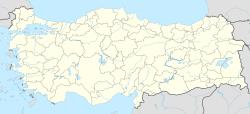- For namesakes, see Apamea
| Location | Turkey |
|---|---|
| Region | Bursa Province |
| Coordinates | 40°22′35″N 28°53′00″E / 40.37639°N 28.88333°E |
Apamea Myrlea (/ˌæpəˈmiːə mərˈliːə/; Ancient Greek: Απάμεια Μύρλεια) was an ancient city and bishopric (Apamea in Bithynia) on the Sea of Marmara, in Bithynia, Anatolia; its ruins are a few kilometers south of Mudanya, Bursa Province in the Marmara Region of Asian Turkey.
Name
To distinguish this city from the many others called Apamea,[1][2][3] the name Apamea Myrlea used here adds to the name (Apamea) it was given when rebuilt as an important city the name (Myrlea) it previously bore as a smaller town.[4] It was also referred to as Apamea Myrlēon (Apamea of Myrlea).[5]
History
The town was founded as a colony of the Colophonians and was called Μύρλεια (Myrleia or Myrlea). Philip V of Macedon took the town, as it appears, during his war against the king of Pergamon, and gave it to his ally, King Prusias I of Bithynia, who fortified and enlarged it – indeed almost rebuilt it[6] – around 202 BC, renaming it Ἀπάμεια (transcribed as Apameia, Apamea, or Apamia), after his wife, Apama III.[2]
The place was on the west coast of the Gulf of Gemlik, and northwest of Bursa, then called Prusa, for which it served as a port.[1]
The Romans made Apamea a colonia, apparently in the time of Augustus, or perhaps Julius Caesar, in view of the adjective "Iulia" that appear on its coins under Roman rule.[2] Its earlier coins were stamped Ἀπαμέων Μυρλεάνων, but in Roman times they bore the label C.I.C.A. (= Colonia Iulia Concordia Apamea).[7]
When Pliny the Younger was governor of Bithynia, he consulted Trajan about a claim by the colonia not to have its accounts of receipts and expenditures examined by the Roman governor.[2]
A passage of Ulpian shows use of the adjectival form of the name was Apamenus: "Apamena: est in Bithynia colonia Apamena.[2]
Ecclesiastical history
This Apamea in the Late Roman province of Bithynia became the seat of a Christian bishop in the 4th century and was at first a suffragan of Nicaea, but became an autocephalous archdiocese some time before the Fourth Council of Constantinople (Roman Catholic) in 869, at which its archbishop Paulus took part.[8][9]
Titular see
No longer a residential bishopric, Apamea in Bithynia is today listed by the Catholic Church as a titular see,[10] of the intermediary Archiepiscopal rank.
Since the Latin Catholic archdiocese was thus nominally restored (in ?1633), it has had the following archiepiscopal incumbents, but is vacant since decades :
- Nicola Maria Tedeschi, Benedictines (O.S.B.) (1722.03.02 – death 1741.09.29), eemritate as former Bishop of Lipari (Italy) (1710.03.10 – 1722.02.28)
- Stefano Evodio Assemani (1736 – death 1782.11.24), no actual office recorded
- Luigi Ruffo Scilla (1785.04.11 – 1801.02.23), as Apostolic Nuncio (papal ambassador) to Austria-Hungary (1793.08.23 – 1802.08.09); later Metropolitan Archbishop of Napoli (Naples) (southern Italy) (1802.08.09 – death 1832.11.17), created Cardinal-Priest of S. Martino ai Monti (1802.08.09 – 1832.11.17), became Protopriest of Sacred College of Cardinals (1830.01.24 – 1832.11.17)
- David Mathew (1946.02.20 – death 1975.12.12), first as Apostolic Delegate (papal legation chief) to British East Africa and British West Africa (1946.02.20 – 1953), then Military Vicar of Great Britain (UK) (1954.04.16 – retired 1963.03.23); previously Titular Bishop of Æliæ (1938.12.03 – 1946.02.20) as Auxiliary Bishop of Westminster (England) (1938.12.03 – 1946.02.20)
See also
References
- ^ a b Hogarth, David George (1911). . Encyclopædia Britannica. 2 (11th ed.). p. 159.
- ^ a b c d e "Apameia" in William Smith, Dictionary of Greek and Roman Geography (1854)
- ^ See also the disambiguation page Apamea
- ^ Charlton T. Lewis, Charles Short, A Latin Dictionary, entry "Ăpămēa"
- ^ William Smith, A Classical Dictionary, p. 83
- ^ William Smith, A Classical Dictionary, p. 581
- ^ Asia Minor Coins – ancient coins of Apamea
- ^ Michel Lequien, Oriens christianus in quatuor Patriarchatus digestus, Paris 1740, Vol. I, coll. 655–658
- ^ Gaetano Moroni, Dizionario di erudizione storico-ecclesiastica, Vol. 2, p. 235
- ^ Annuario Pontificio 2013 (Libreria Editrice Vaticana 2013 ISBN 978-88-209-9070-1), p. 834
Sources and external links
Further reading
- Richard Talbert, Barrington Atlas of the Greek and Roman World, (ISBN 0-691-03169-X), p. 52.
- Stephanus of Byzantium, s. v. Apameia
